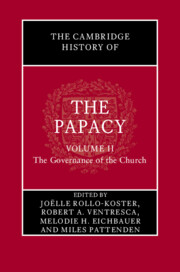Book contents
- The Cambridge History of the Papacy
- The Cambridge History of the Papacy
- Copyright page
- Contents
- Figures
- Tables
- Maps
- Contributors
- General Introduction
- Part I The Pope within the Church
- Part II The Roman Curia
- Part III Canon Law
- 13 The Medieval Papacy and Canon Law
- 14 Canon Law in the Early Middle Ages
- 15 Gratian’s Decretum: The Transmission and Fluidity of Legal Knowledge in the Twelfth Century
- 16 Papal Decretals
- 17 Papal Law in the English Church: Post-Reformation Anglican Jurisprudence
- 18 The Codes of Canon Law: 1917, 1983, 1990
- 19 The Pope in the Two Latin Codes, 1917 and 1983: Current Status and Discussion of Possible Developments
- Part IV Finance
- Part V Papal States
- Select Bibliography
- Index
18 - The Codes of Canon Law: 1917, 1983, 1990
from Part III - Canon Law
Published online by Cambridge University Press: 28 February 2025
- The Cambridge History of the Papacy
- The Cambridge History of the Papacy
- Copyright page
- Contents
- Figures
- Tables
- Maps
- Contributors
- General Introduction
- Part I The Pope within the Church
- Part II The Roman Curia
- Part III Canon Law
- 13 The Medieval Papacy and Canon Law
- 14 Canon Law in the Early Middle Ages
- 15 Gratian’s Decretum: The Transmission and Fluidity of Legal Knowledge in the Twelfth Century
- 16 Papal Decretals
- 17 Papal Law in the English Church: Post-Reformation Anglican Jurisprudence
- 18 The Codes of Canon Law: 1917, 1983, 1990
- 19 The Pope in the Two Latin Codes, 1917 and 1983: Current Status and Discussion of Possible Developments
- Part IV Finance
- Part V Papal States
- Select Bibliography
- Index
Summary
Canon law has played a role in the life of the Church since its earliest days. For many centuries, it was largely customary and local. However, from the sixth century on, the Roman pontiff played an increasingly prominent role in shaping and applying this law in the West. This tendency to centralize authority in the hands of the Roman pontiff reached its culmination with the promulgation of the first Code of Canon Law in 1917. Cut off from the law’s roots in history and theology, this code derived its force from the will of the pontiff who enacted it. The Second Vatican Council, from 1962 to 1965, attempted to balance the role of the pope with that of the College of Bishops and to move toward decentralization of authority by enhancing the figure of the diocesan bishop and creating episcopal conferences. These conciliar efforts have been implemented, at least in part, in the revised Latin code of 1983 and the Code of Canons of the Eastern Churches of 1990. Nevertheless, subsequent legislating has come largely through the unilateral action of the Roman pontiff.
Keywords
- Type
- Chapter
- Information
- The Cambridge History of the Papacy , pp. 466 - 491Publisher: Cambridge University PressPrint publication year: 2025

